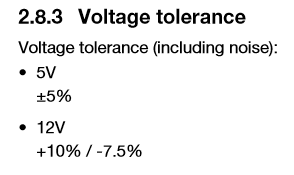4
1
After doing my own testing with multimeters, I've edited this question from the original title "Why does WD Caviar Green use more power than Caviar Black?".
I have two old 1TB Western Digital hard drives laying around, and I want to use one in a low power Raspberry Pi system with a tiny PSU. Looking at the power requirements printed on the drives, I see this:
╔════════╦═══════════════╦═══════════════╗
║ ║ Caviar Black ║ Caviar Green ║
╠════════╬═══════════════╬═══════════════╣
║ 12VDC: ║ 0.55A ║ 0.55A ║
║ 5VDC: ║ 0.68A ║ 0.70A ║
║ Date: ║ 2009 ║ 2011 ║
╚════════╩═══════════════╩═══════════════╝
The green series is known for its low power consumption, so why would it require more max power? It's also 2 years newer than the black, so I would expect they made efficiency improvements in that time.
Western Digital's spec sheet for the green drive shows:
12VDC: 1.671A peak
It makes no mention of 5V.
The spec sheet for the black drive does not mention voltage at all, but it says:
Average read/write power requirement: 6.8W
Now I measure voltage and current with 2 multimeters, and get quite different results. I recorded the maximum observed current, and the simultaneous voltage.
╔════════╦════════════════╦════════════════╗
║ ║ Caviar Black ║ Caviar Green ║
╠════════╬════════════════╬════════════════╣
║ spinup ║ 1.88A @ 11.35V ║ 0.59A @ 11.67V ║
║ write ║ 0.48A @ 11.77V ║ 0.24A @ 11.92V ║
║ idle ║ 0.49A @ 11.74V ║ 0.20A @ 11.76V ║
║ ║ ║ ║
║ spinup ║ 0.44A @ 4.95V ║ 0.45A @ 4.94V ║
║ write ║ 0.50A @ 4.93V ║ 0.56A @ 4.92V ║
║ idle ║ 0.36A @ 4.96V ║ 0.12A @ 5.00V ║
╚════════╩════════════════╩════════════════╝
The listed specs are nowhere close to the real-world measurements I got. Why? And how can low-power system builders get enough information to spec power supplies?
